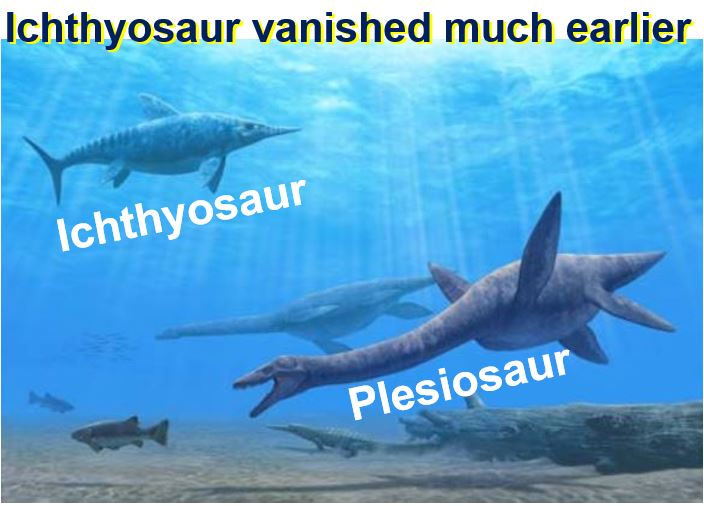Ichthyosaurs, marine animals that looked like a cross between a dolphin and a fish and existed at the time of the dinosaurs, were killed off by a dramatic climate change about 100 million years ago, when the oceans became warmer, sea levels rose considerably, their food supply became scarcer, new predatory marine creatures emerged, and habitats were affected.
According to scientists from the University of Oxford in England, University of Liège in Belgium, Sorbonne Universités in France, and Saratov State Technical University in Russia, the ichthyosaurs (Greek for ‘fish lizard’ – ιχθυς or ichthys meaning ‘fish’ and σαυρος or sauros meaning ‘lizard’) were not able to adapt to the new environment, which sealed their fate.
This study, which was reported in the scientific journal Nature Communications (citation below), is the latest twist in the enigmatic story of how and why these predators became extinct.
 Scientists became aware of the existence of ichthyosaurs in the early 19th century when the first complete skeletons were found in the UK. In 1834, the order Ichthyosauria was named. Later in the 19th century several well-preserved fossil specimens were discovered in Germany, including soft tissue remains. Since the late 20th century, there has been a revived interest in the species, leading to an increased number of named ichthyosaurs from all corners of the globe. (Image: Wikipedia)
Scientists became aware of the existence of ichthyosaurs in the early 19th century when the first complete skeletons were found in the UK. In 1834, the order Ichthyosauria was named. Later in the 19th century several well-preserved fossil specimens were discovered in Germany, including soft tissue remains. Since the late 20th century, there has been a revived interest in the species, leading to an increased number of named ichthyosaurs from all corners of the globe. (Image: Wikipedia)
Evidence is becoming increasingly compelling that approximately 100 million years ago intense climate change was more than they could cope with and killed them off.
Lead researcher, Dr Valentin Fischer, from both the Universities of Oxford and Liège, said:
“The ichthyosaurs were unable to adapt. They were evolving very slowly during the last 50 million years of their reign. When the environment changed very rapidly they couldn’t keep up with this change.”
Ichthyosaur of all sizes swam in our seas
Up to 100 million years ago, when dinosaurs roamed the land, ichthyosaurs of many different sizes – ranging in length from 1 metre (3.28 feet) to over 16 metres (52.5 feet) – swam in our oceans.
Their bodies became extremely streamlined, just like modern dolphins’ – built for speed. They fed on fish, squid and other marine creatures.
 According to Dr. Fischer, rising sea temperatures and sea levels profoundly reorganised marine ecosystems 100 million years ago. (Image: royalsociety.org)
According to Dr. Fischer, rising sea temperatures and sea levels profoundly reorganised marine ecosystems 100 million years ago. (Image: royalsociety.org)
The fish lizard survived for millions of years. We believe they emerged in the Triassic (252 million years ago), and reached their peak in the Jurassic (145 million years ago), and then disappeared in the Cretaceous. They died many millions of years before the dinosaurs became extinct.
Researchers had suggested that they disappeared because their food supply became scarce, as other marine creatures including bony fishes and sharks appeared.
Lack of food one of many factors
The researchers believe lack of food was a factor contributing to the disappearance of the species, but not the only one.
After drawing up an extremely-detailed family tree of ichthyosaurs’ evolution and analysing possible causes of their disappearance, the scientists believe that many factors were involved.
Dr. Fischer explained:
“Although the rising temperatures and sea levels evidenced in rock records throughout the world may not directly have affected ichthyosaurs, related factors such as changes in food availability, migratory routes, competitors and birthing places are all potential drivers, probably occurring in conjunction to drive ichthyosaurs to extinction.”
 Ichthyosaurs vanished much earlier than plesiosaurs, which faced the same climate change and environmental challenges. Why? Their earlier extinction remains a mystery. (Image: thenaturalhistorian.com)
Ichthyosaurs vanished much earlier than plesiosaurs, which faced the same climate change and environmental challenges. Why? Their earlier extinction remains a mystery. (Image: thenaturalhistorian.com)
In an interview with BBC News, Dr. David Martill, Reader in Palaeobiology at the University of Portsmouth’s School of Earth and Environmental Sciences, who was not involved in the study, said the move to a ‘super greenhouse world’ would have severely altered the habitats of both land and marine creatures.
Several other marine animals shared the ocean with ichthyosaurs, including plesiosaurs and mosasaurs, however, which managed to survive for considerably longer.
Dr. Martill said:
“They [the ichthyosaurs] just disappear while a lot of animals living alongside did alright. Some mysterious thing was involved. I think it’s still an enigma.”
In an Abstract in the journal, the authors wrote:
“Our results support a growing body of evidence revealing that global environmental change resulted in a major, temporally staggered turnover event that profoundly reorganized marine ecosystems during the Cenomanian.”
Citation: “Extinction of fish-shaped marine reptiles associated with reduced evolutionary rates and global environmental volatility,” Valentin Fischer, Matt Friedman, Nathalie Bardet, Maxim S. Arkhangelsky & Roger B. J. Benson. Nature Communications. 8 March, 2016. DOI: 10.1038/ncomms10825.
